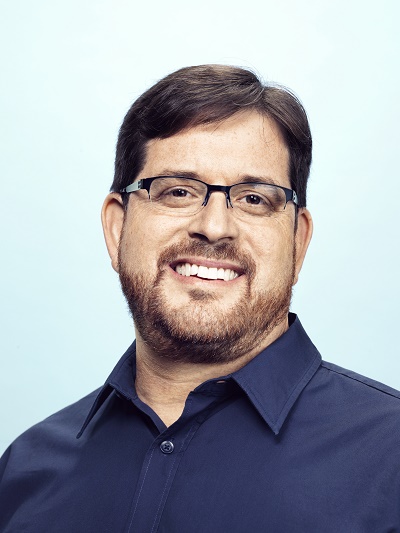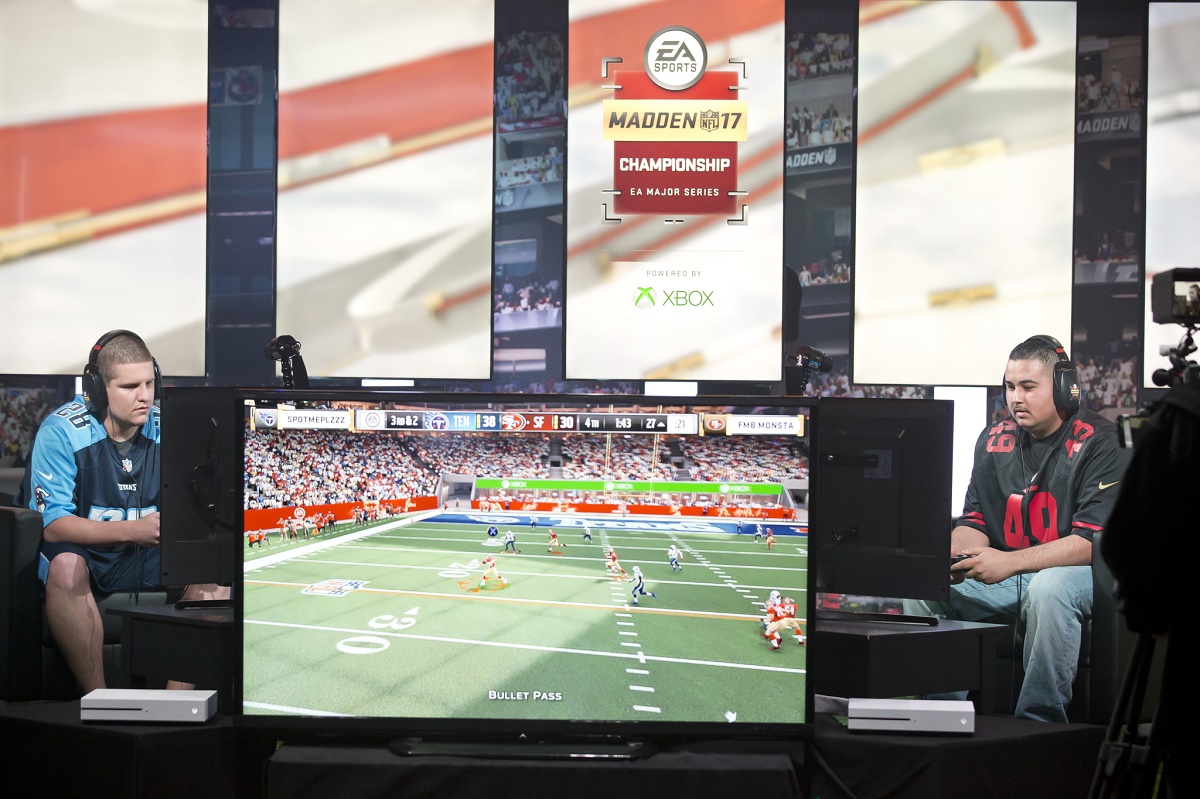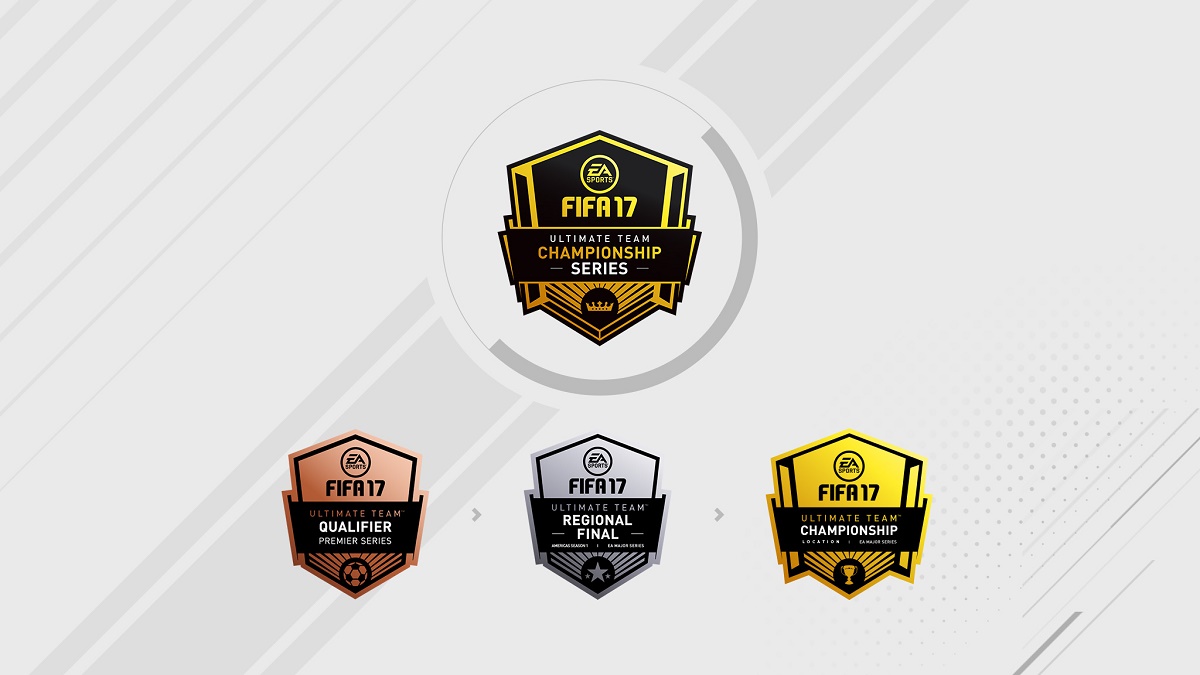This weekend, a lot of gamers are going to sit around and watch cyberathletes play video games in the FIFA 17 world championships, just a week after the Madden NFL 17 finals.
In the physical world, pro football and soccer events are among the biggest spectator sports in the world. But Electronic Arts is making progress in getting fans to watch digital versions of those sports in the form of video game esports tournaments.
It may sound like the strangest thing in the world that fans would spectate gamers playing a multiplayer match of a Madden NFL Football video game or FIFA 17. But EA is drawing bigger and bigger crowds as it levels up “competitive gaming,” as it prefers to call the esports phenomenon.
Todd Sitrin, Electronic Arts senior vice president and Competitive Gaming Division general manager believes that each level of competitive gaming is gaining momentum, from the professional esports players competing for real money at the top to the casual players competing among friends at the bottom of the pyramid.
June 5th: The AI Audit in NYC
Join us next week in NYC to engage with top executive leaders, delving into strategies for auditing AI models to ensure fairness, optimal performance, and ethical compliance across diverse organizations. Secure your attendance for this exclusive invite-only event.
EA is giving out its largest prize pools ever, and it’s a sign that pro players could make a full career out of playing esports. The FIFA Ultimate Team Championship series takes place May 20-21 in Berlin. I talked with Sitrin about the phenomenon of competitive gaming.
Here’s an edited transcript of our interview.

Above: Todd Sitrin, senior vice president and general manager of Competitive Gaming Division at EA.
GamesBeat: [Former EA chief competition officer] Peter Moore talked about a pyramid in the way EA views competition. I assume you’re moving forward on that same general strategy?
Todd Sitrin: Very much so. When we started out the CGD, we had a mission to make stars out of all of our players. The key word for us there is “all.” Whether you play in our games competitively – the base of the pyramid – or whether you start to move up toward the top, where you’re competing in live events, and then obviously the pinnacle is happening this week for Madden, and next week for FIFA—we think that no matter where you are in that pyramid, we should celebrate our players. That’s what we set out to do from the first day.
GamesBeat: What’s some of the execution on that strategy?
Sitrin: It starts at the base of the pyramid, which is about game competitions. In FIFA 17 we introduced a new competitive mode, FIFA Ultimate Team Champions. Players come in and take part in a competition that happens every week with great prizes and advancement up a leaderboard. That mode became extremely popular. Millions of people have played it this year as their first step into competitions.
From there, it creates a leaderboard of players. The people at the very top then were able to advance to live competitions. This last year in Madden, we did many different competitions in different sizes. Some were lower on the pyramid, what we call the challenger events. These were community-based competitions. We had around 10 throughout the year for Madden, where small community groups would come together and have competitions we sanctioned.
Then you go up to what we call the premier level, a bit higher up the pyramid. With FIFA we did premier competitions all around the world – maybe 15 of them. These were more established competitions, more country-based or region-based. We held a competition, for instance, in Sweden during Dreamhack. We had one in France with Vivendi and the Ligue 1 football league.
At the very top was what we call the EA Majors. This year, for Madden, we held three Majors ahead of the championship we’re doing this weekend. On the FIFA side we held a total of seven Majors leading into the final, which is going to be in Berlin. So really, whether it was at the base level – introducing new competitions in the game – or community-based, more local competitions, or premier country-wide competitions, or EA Majors at the global level, we’ve significantly increased the competition going on in all parts of the pyramid over the last year.
GamesBeat: Do you have any numbers associated with that, like engagement or the number of players involved?
Sitrin: We’re up to millions of people participating at the base level across our games. Probably in the tens of millions. I don’t know exact numbers on how many people made it to live events, but we certainly have hundreds, several hundreds coming into our live events around the world. Our finals have a much smaller number of players getting invited, but to become the best FIFA or Madden player in the world, you’re competing against millions of players.

Above: EA’s Madden competitive gaming league.
GamesBeat: How is the audience side developing, as far as spectators or broadcasting?
Sitrin: We’re focusing on accessibility. Our games are clearly more accessible to viewers than any other competitive games out there. Most of the competitive games that have helped develop this marketplace have been very hardcore, very deep strategy games, that are hard for viewers to understand. One benefit we’ve had with Madden and FIFA is that people already understand the rules of the game, because they’re fans of the sport. People are familiar with the teams and players. Accessibility has been a big part of the strategy for us.
That also relates to how we approach distribution. We try to make it as wide as we can. No matter where you are, what platform you’re on, or where you like to normally watch content, we should make our stuff available to you. This year we broadcast live on YouTube and Twitch and Facebook. We also went out and partnered with more traditional broadcasters, linear television broadcasters, for the major countries where our player base resides.
For Madden, we broadcast through the NFL Network. We also did a partnership with Univision in Mexico. For FIFA, we partnered with ESPN in North America, Central America, South America, Australia, and New Zealand. We also partnered with BT Sports. We have some other partnerships we’ll be announcing shortly that will expand the reach of our competitions, again with the idea that we make accessibility a focus of what we’re doing.
GamesBeat: Do you have any numbers there as well, anything showing how that’s changed or improved?
Sitrin: We haven’t released numbers yet, although some are available through Nielsen and those sorts of things. We’ve been increasing our viewership throughout the year. That’s a great sign. A part of that is adding distribution, but a lot of it is also just people getting used to the fact that this is happening and building an audience. That’s going to take us a while to do, but we’re very happy with what we’ve accomplished. Certainly tens of millions of people have watched our competitions over the past year. You can safely say that our games are being carried by more broadcasters around the world than any other game in esports.
GamesBeat: Do you think you’re overcoming the issue of people preferring to watch traditional TV sports versus esports?
Sitrin: Again, TV is just one of the outlets. We reach a complementary, but in some ways different audience than what might exist in the real world – a digital-savvy millennial and Gen Z audience, a much younger audience is the primary target for competitive gaming. There’s a role for both types of competitions.
When you play FIFA, we’re able to do things that don’t happen in the real world. You can see people who aren’t just players on the field, but simultaneously the manager and the owner of the team. They get to assemble, through Ultimate Team, their fantasy team to put on the field. That’s why you see these great players all coming together in our games that never would in real life. It’s a different experience. One is not necessarily in competition with the other. What competition and entertainment is all about is having people face off with something on the line and seeing the best person win. That can be entertaining in either environment.
GamesBeat: What sort of expectations do you have as far as your big events coming up?
Sitrin: If it’s anything like what we’ve seen so far, you’ll have the best competition from the very best players. Just like in any other sporting competition, when you progress, the competition gets more intense. With FIFA, we’ve had regionals all around the world, but the best players from each region haven’t faced each other yet. We have a big prize pool on the line. We have the recognition of being the best player. Players may have the opportunity to get signed up by sponsors or professional teams. That creates a lot of excitement and energy and pressure. From what we’ve seen to date, that manifests in very emotional reactions, be it positive or negative. It’s an entertaining viewing experience. I expect we’ll see an order of magnitude more, because there’s even more than that on the line.

Above: EA’s Madden pro sports competition.
GamesBeat: What sort of prizes do you have at stake?
Sitrin: The prize pool for Madden, in total this year, was $1 million for the entire championship series. For the championship itself, which is part of that, it’s $500,000. The winner walks away with $100,000. Second place gets $70,000. The overall prize pool for FIFA was $1.3 million, for the championship the pool is $400,000, and the overall winner will get $160,000.
Maybe just a few months ago you could have been playing at the bottom of our pyramid, in the in-game qualifiers. A few months later you’re sitting down in front of a live audience, broadcast on television, broadcast globally through our digital platforms. It’s a lot of pressure. I think we’re guaranteed a great viewing experience.
GamesBeat: How do you feel about where EA stands in this area relative to other game companies?
Sitrin: We have a unique experience. We’re very different in the sense that we have very accessible games. We have E-for-Everyone games. From the viewer’s standpoint, they’re very easy to understand. We’re also different when it comes to broadcasting, because of that focus on accessibility, and because of all the broadcasters around the world that have made investments in these sports and sports leagues.
When you look at brands coming in, it’s a lot easier for those brands to become involved with games as accessible as ours. I think that’s why you’re starting to see some of that attention coming toward EA, and I expect that will continue.
GamesBeat: What’s the vision over the long term? Where do you want this to go?
Sitrin: Our long term vision hasn’t changed. It all goes back to making stars of all our players. It’s always been about celebrating our players’ passion for competition. Competition is at the heart of the games we make at EA. We want to recognize and celebrate what the community has enjoyed, but now we’re just elevating it.
Our focus is on engaging both players and spectators. We’re going to continue to build out engagement in both regards. We’ll see further advancements in the aspects of the game, the competitions inside the game. Champions is a great example of year one. We’ll continue to make advancements and make it more rewarding for people to play our games.
We’ll also be building out the spectator experience. Everyone’s learning, across the industry, how to make that experience more compelling and build that audience. We have a lot of important partners working with us – BT Sport, ESPN, NFL Network, Twitch, Facebook, YouTube, and so on. They’re aligned with our goals, to make it as fun to watch the competitions as it will be to play in the competitions.
GamesBeat: From what I saw this year, especially around Microsoft’s Halo event, the expectations for fans at live events are going up. They want a great experience in the arena. As things get bigger, they want that experience to improve.
Sitrin: There’s definitely an in-event experience that has to be rich in terms of what you’re offering. For us, our focus in this first year has been around the competitors themselves, making sure they have a great experience and they’re satisfied with how we’re running competitions. We do surveys of those players routinely and they’re thrilled with what we’ve been able to do in the first year. Our other primary focus has been the broadcast audience. Obviously we can reach tens of millions of people through that avenue.
Our focus at EA, at least in this first year, has not been as much about the in-house experience. We make it very good for those who attend, but we’re not trying to fill large stadiums right now. We’d rather make sure the competitors are having a great experience, and the broadcast audience as well.

Above: EA’s FIFA competitive gaming tiers.
GamesBeat: As far as where the revenue is, is there a particular source that turns out to be the best option for competitive gaming?
Sitrin: There are many sources that the industry’s been talking about around this. They include game sales. But in the case of EA’s titles and many titles from other publishers, there’s a monetization that occurs after you purchase the game, microtransactions and that type of revenue. That’s obviously substantial. Then you get into sponsorships and advertising. You have distribution rights for live events, event fees. There are lots of other opportunities here.
It’s early days. We’ll see how those develop. But we know that Ultimate Team in Madden and FIFA have been incredible for engagement with our players. That engagement means they’re playing our games more and generating more in-game revenue opportunities.
We’ll continue to grow this for FIFA and for Madden. We’ll be discussing our plans for Battlefield, which will be our third big step into competitive gaming, a little bit later this year.


